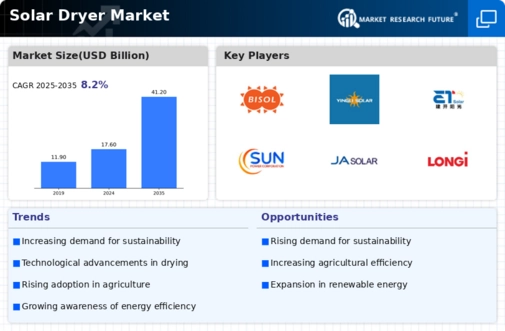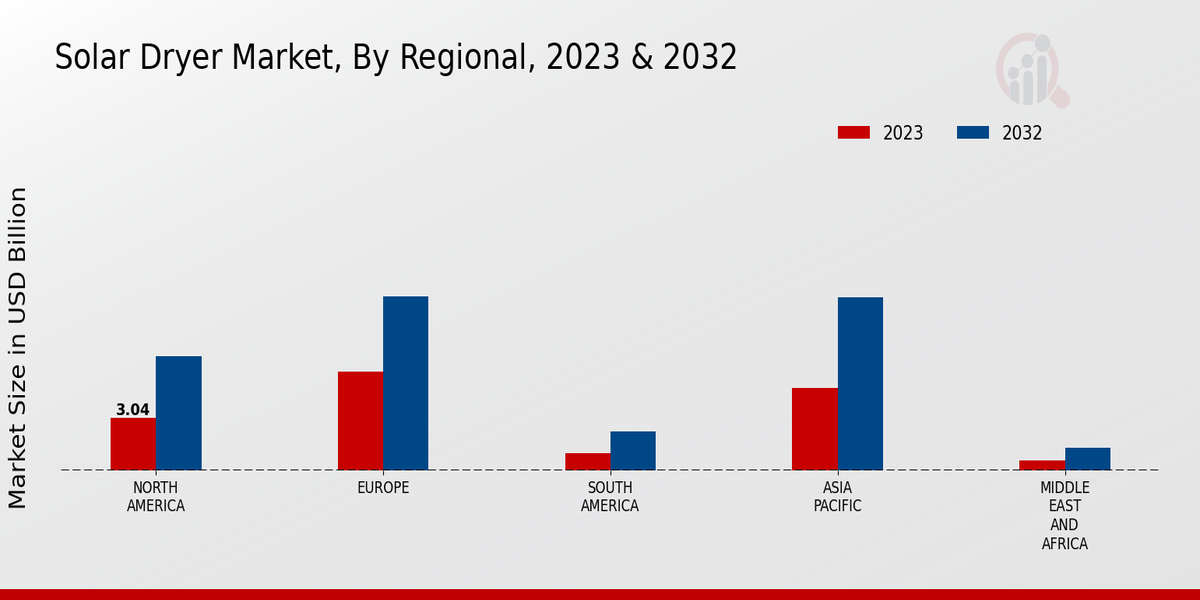Market Growth Projections
The Global Solar Dryer Market Industry is poised for substantial growth, with projections indicating a market value of 41.2 USD Billion by 2035. This anticipated growth is underpinned by a compound annual growth rate of 8.04% from 2025 to 2035. The increasing adoption of solar drying technologies across various sectors, including agriculture and food processing, is expected to drive this expansion. As stakeholders recognize the benefits of solar dryers in enhancing efficiency and sustainability, the market is likely to witness a robust increase in investment and innovation.
Government Support and Incentives
Government initiatives and incentives significantly bolster the Global Solar Dryer Market Industry. Many countries are implementing policies aimed at promoting renewable energy technologies, including solar drying systems. Financial incentives, such as subsidies and tax breaks, encourage both manufacturers and consumers to invest in solar dryers. For example, various agricultural programs worldwide are designed to support farmers in adopting solar drying technologies, thereby enhancing food security and reducing waste. This supportive regulatory environment is expected to sustain the market's growth trajectory, contributing to a compound annual growth rate of 8.04% from 2025 to 2035.
Increasing Agricultural Production
The rise in global agricultural production directly influences the Global Solar Dryer Market Industry. As food production increases to meet the demands of a growing population, the need for effective post-harvest management becomes critical. Solar dryers offer a viable solution to reduce moisture content in crops, thereby preventing spoilage and enhancing shelf life. This is particularly relevant in regions where traditional drying methods are inefficient. The adoption of solar drying technology can lead to improved quality and marketability of agricultural products, further driving the market's expansion as farmers seek to optimize their operations.
Growing Demand for Sustainable Solutions
The Global Solar Dryer Market Industry experiences a surge in demand for sustainable drying solutions as environmental awareness increases. Consumers and businesses alike are gravitating towards eco-friendly alternatives to traditional drying methods, which often rely on fossil fuels. This shift is evidenced by the projected market value of 17.6 USD Billion in 2024, reflecting a growing preference for renewable energy sources. The emphasis on sustainability not only aligns with global climate goals but also enhances the appeal of solar dryers in agricultural sectors, where they can reduce post-harvest losses and improve product quality.
Rising Awareness of Food Safety Standards
The Global Solar Dryer Market Industry benefits from the increasing awareness of food safety standards among consumers and producers. As food safety regulations become more stringent, the need for reliable drying methods that ensure product quality and safety is paramount. Solar dryers, which minimize contamination risks and preserve nutritional value, are becoming a preferred choice for food processors and farmers. This heightened focus on food safety is likely to propel the adoption of solar drying technologies, as stakeholders recognize the importance of compliance with safety standards in maintaining consumer trust and market access.
Technological Advancements in Solar Drying
Technological innovations play a pivotal role in the expansion of the Global Solar Dryer Market Industry. Enhanced designs and materials have led to more efficient solar dryers that maximize energy capture and minimize drying time. For instance, the integration of smart sensors and automation in solar drying systems allows for better monitoring and control of drying conditions. These advancements contribute to the overall effectiveness of solar dryers, making them more attractive to users. As the market evolves, the adoption of these technologies is likely to drive growth, with projections indicating a market size of 41.2 USD Billion by 2035.

























Leave a Comment